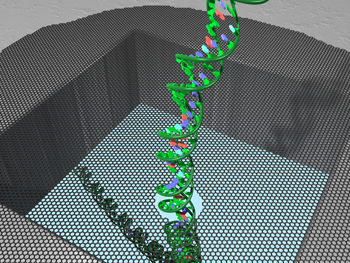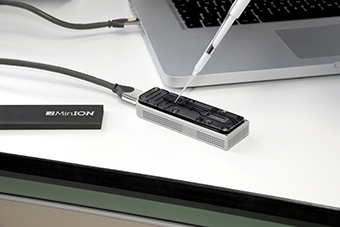May 7, 2015 – It is called MinION and you pack the device in your overnight bag along with a laptop computer. When you arrive at your destination get set up in the field and start DNA testing right away with results in as little as 48 hours. Portable, inexpensive and fast, this is a revolutionary step in the evolution of gene sequencing.
When Ebola broke out in West Africa, MinION came to Guinea with health research teams who began sequencing the virus genome. In one test 14 Ebola patients provided samples helping epidemiologists in the field to track to the source of the infectious outbreak. Within 48 hours the team had the results which they could display on laptops running MinKNOW, the software application developed to analyze test samples. MinKNOW results are shared in the cloud making the information accessible to global medical teams helping to fight epidemics such as the one that struck West Africa infecting 26,312 and killing 10,899 as of April 26, 2015.
MinION is a palm-sized gene sequencer developed by Oxford Nanopore Technologies. The company’s head office is in Oxford, UK with manufacturing facilities in Cambridge, Massachusetts. The MinION device comes with a USB plug-in, a software application called MinKNOW, the latter which displays results of sample analysis on a laptop display screen. In the rollout of the technology first adopters have been able to license the technology for a deposit of $1,000 U.S.
This month a biology team from Italy is using MinION to sequence the genome of a rare Tanzanian species of frog. And now potential users are pushing Oxford to port the software app for use on smartphones. As one scientist, Nicholas Loman at University of Birmingham, described it, “this is democratization of sequencing.”
What is the technology behind MinION? Nanopore sensing devices fabricated from synthetic materials such as silicon nitride and silicon dioxide. A nanopore is a nanometer-sized hole that when combined with integrated sensors can measure the properties of a liquid passing through it. The MinION contains a graphene honeycomb lattice containing these nanopores. A mere one atom thick the membrane is so thin that DNA can pass through it and be read by the built-in sensors. This makes it possible to sequence the genome of microbes from bacteria to viruses, and even do in the field partial sequencing of human DNA. The illustration below is an artist depiction of how MinION‘s honeycomb lattice can facilitate coding of DNA.
If Oxford can port its software to smartphones then citizen scientists will suddenly have a tool capable of sampling and sequencing DNA in the field. NASA has plans to send MinION to the International Space Station to test the technology in microgravity. If that works then the next Mars rover may have MinION on board to look for molecular signs of life.




















